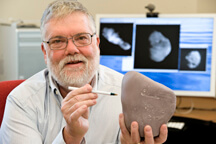Comet expert eager to learn from Rosetta landing
November 11, 2014
 |
|
Jay Melosh, a distinguished professor of earth, atmospheric and planetary sciences, physics and aerospace engineering at Purdue, holds a model of the comet Tempel 1. (Purdue University file photo/Andrew Hancock) |
WEST LAFAYETTE, Ind. - A Purdue University expert who has been a part of three NASA space missions to examine comets is eagerly awaiting the Rosetta mission’s planned landing Wednesday (Nov. 12) on a comet’s surface.
Jay Melosh, a distinguished professor of earth, atmospheric and planetary sciences, physics and aerospace engineering, has studied comets for 11 years and hopes a rare close view of another comet will provide some answers to the many questions that remain about the enigmatic cosmic objects.
Space missions are necessary to study comets because they stay, for the most part, millions to billions of kilometers away from Earth, where even the most powerful telescopes can't get very detailed images, he said.
“So far almost all of the comets we’ve looked at have been different,” Melosh said. “We want to know more about the variation in comets and what it tells us about the time and place where they were born. Comets were formed in cold parts of our solar system where they were exposed to less processing by the sun’s heat and so retain more clues about their birth. The underlying goal of any comet mission is to learn more about the comet’s birthplace and, by extension, that of our own solar system.”
Melosh was part of the NASA science team of the 2005 Deep Impact mission that launched a probe into the comet Tempel 1. He then was part of the 2010 EPOXI mission, when the Deep Impact spacecraft came within about 434 miles of the comet Hartley 2. He also was part of NASA’s 2011 Stardust New Exploration of Tempel 1, or Stardust NExT, mission that returned to the comet to examine the impact crater created by the earlier mission and to study changes in the comet as it approached the sun. The spacecraft flew within about 112 miles of the comet.
On Wednesday the Rosetta mission plans to gently land the robotic probe Philae on the comet 67P/Churyumov-Gerasimenko. This would be the first ever soft landing on a comet.
“The Rosetta mission will provide a longer, closer look at a comet and gentler probing of it,” Melosh said. “In the Deep Impact mission we, in essence, blasted a hole in the comet’s surface and analyzed what was ejected from the impact. The Rosetta mission offers the chance to perform a precision analysis of the comet’s surface and to see how the material is layered and arranged. We are all looking forward to the results.”
The Rosetta spacecraft arrived at the comet in August 2014 and will escort the comet through its orbit until it passes its closest point to the sun in July 2015. As the surface of the comet warms from the sun’s heat it will release jets of gas and dust that are of particular interest to Melosh. He has studied these jets and, in 2008, published a probable mechanism for the sudden brightenings called “outbursts” on comets.
“These jets are a very poorly understood phenomenon,” he said. “It was initially thought that these jets came through cracks in the surface, like geysers. However, in our missions we did not see any cracks or craters that could be the source of these jets. The gas seems to just percolate through the loose surface of the comet and then jet out into space carrying big clumps of dust with it.”
Melosh hopes images taken during the Rosetta mission will provide further insight.
The European Space Agency leads the Rosetta mission with support and instruments from NASA.
Writer: Elizabeth K. Gardner, 765-494-2081, ekgardner@purdue.edu
Source: Jay Melosh, jmelosh@purdue.edu
Related news releases:
Purdue professor, student part of NASA comet mission: http://www.purdue.edu/newsroom/events/2010/101102MeloshEPOXI.html
Purdue scientist part of NASA return mission to comet: http://www.purdue.edu/newsroom/research/2011/110215MeloshStardust.html
Note to Journalists: Jay Melosh will be in Tucson through Nov. 14 attending the annual meeting of the Division for Planetary Sciences of the American Astronomical Society and may not be able to immediately respond to requests.

